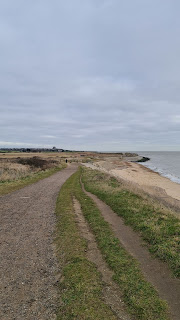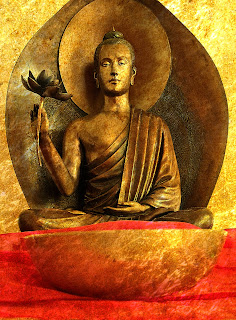The other morning I walked the mile from my temporary lodging to Colchester Town rail station, and took the 9.07 (am) train to Walton on the Naze. It was a beautifully clear, sunny day. Excitement was mounting as I entered the coach, wondering what changes there might have been in the twenty years since I was last in Walton. In the carriage I really did try to obey all the Greater Anglia rules. I wore a face mask, and did try to social distance myself, but as I was alone in the carriage that proved to be difficult. An official announcement suggested that I spread out as much as possible throughout the train. I only managed about a six foot circumference.
Having dashed out comparatively early (well, 8.30 am, which admittedly isn’t early for some people), the only breakfast I had was an ageing banana and a 3 in 1 coffee (as I'd run out of coffee bags). I really do miss my Malaysian 'sock', handy for straining tea or coffee. I’ve desperately tried to find the name of the ‘sock’ used for beverages but so far the only word used, that I could find in Malaysia, is ‘sock’. Elsewhere in the world it’s called a ‘chorreador’ (Costa Rica).
As the day brightened, a Winter sky developed to eggshell blue and the sun became bright, but cold. It was my 71st birthday. As this year, one year ago today I spent my birthday (70th) alone, apart from a tuk tuk driver. We were in Angkor, visiting the Buddhist and Hindu Wats (temples), in Cambodia. There really could not have been two more different venues for an annual celebration of birth than the Essex coast and Angkor city of Wats.
Winter trees and hedgerows became silhouetted by the sun as I travelled on the not uncomfortable railway train. It's the same route I took a few weeks back, but instead of disembarking at Frinton I was going further, to Walton and attempting the coastal walk back to Frinton, then a train back from Frinton to Colchester Town.
Walton under the Nase as it was known by Daniel Defoe (‘A tour in circuits, through the island of Great Britain, Letter I’, back in 1722), is now called Walton-On-The-Naze. The Naze (according to Wikipedia) being derived “from Old English næss "ness, promontory, headland". Confusingly it’s also known as “Walton le Soken”. Again from Wikipedia (because I’m far too lazy to go searching elsewhere for trivia) “Sokens is a name often used to describe the area containing the traditional parishes of Thorpe, Kirby and Walton, which now lie in Tendring district in the Naze area of northeast Essex. ... The name 'Soken' is derived from the Saxon 'soc' or 'soca', signifying immunity, peculiar privileges and jurisdiction”. So now you know.
Sadly, all Mr Defoe could find to recommend in Walton (before he hurried over to Harwich) was “a round bricktower, near 80 foot high” and the fact that there were a significant number of “Copperas Houses”, or places where Copperas or green vitriol (ferrous sulphate) was processed (and supposedly used for a variety of purposes including inks and dyes). Back in the 1700s there was no pier. Mind you, there is hardly a pier there now as it’s “temporarily closed”.
Back in the day, my charitable younger self (and others) would escort teams of ‘Care in the Community’ subjects (that is people who had found shelter in a psychiatric institution, only to be thrown out and on to the mercy of the uncaring public, due to shortages of both finance and caring) from Clacton on Sea, to Walton Pier to play ‘Ten-Pin Bowling’, one afternoon per week.
My memories, as memories will, drift even further back to a Walton which had a boating ‘lake’, where I and school friends would attempt to learn the intricacies of staying afloat in canoes (kayaks). I loved it, but outgrew it. Next, came early teen longings for female company and the hunting of female prey, with another friend, now my oldest friend (56 years). We failed miserably. This was because we failed to understand the notion of ‘Day Tripper’ (as portrayed by The Beatles, in the song of the same name). At 71, he and I are both, now, single, with no intention of repeating past mistakes.
And so to the ‘Pier’
The original pier was built in the 1870s, but has undergone great difficulties ever since. At present the latest version, sans Victorian merry go round, is closed and, although workmen were there, appeared desolate. Walton on the Naze itself felt no better. I appreciate that it was off season, but I had the distinct impression that these seaside towns (Clacton and Walton certainly) had seen much better days.
The sea side walk to Frinton on Sea was much shorter than I had imagined, and very quickly I was entering that charity shop town for the second time in recent times.
I had thought of lunching there but, honestly, couldn't find anywhere suited to a birthday lunch. I got the train back to Colchester Town several hours quicker than I had envisaged and ate at Fai's Chinese restaurant instead.
There will be other days, other walks, I hope…yesterday's was 5.5 miles.







